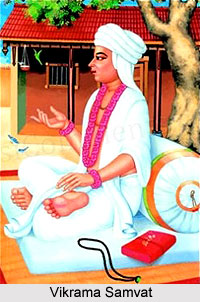 The Vikram Samvat had descended continuously with historical times, along with the Saka era. The reckoning of the era pointed out that it originated from 58 B.C. The Vikrama Era also became an alternative of the Saka era or Sakabda in Central and Western India. In 5th century A.D., Chandragupta II or Vikramaditya ousted the Sakas from the region. But he had no connection with the Vikrama era whatsoever, because Vikrama era started in 58 B.C., which was long before the ascension of Chandragupta II as a king. In 8th century A.D., with the development of the legend of Sakari Vikramaditya, the Vikrama era became associated with the name of Vikramaditya.
The Vikram Samvat had descended continuously with historical times, along with the Saka era. The reckoning of the era pointed out that it originated from 58 B.C. The Vikrama Era also became an alternative of the Saka era or Sakabda in Central and Western India. In 5th century A.D., Chandragupta II or Vikramaditya ousted the Sakas from the region. But he had no connection with the Vikrama era whatsoever, because Vikrama era started in 58 B.C., which was long before the ascension of Chandragupta II as a king. In 8th century A.D., with the development of the legend of Sakari Vikramaditya, the Vikrama era became associated with the name of Vikramaditya.
Authentic facts are not available till date about the origin of the Vikrama era. Historians are in utter confusion regarding the origin and founder of the Vikrama era. However there are several theories approached by the scholars which shed some light regarding the origin of the Vikrama Era.
Tradition runs that a very powerful and accomplished king named Vikramaditya of Ujjaini founded the era of Vikrama Samvat. Jain writer Merutunga supported the tradition and had explicitly stated that Vikramaditya recaptured Ujjaini by defeating the Sakas and commenced the Vikrama Samvat era in his name. The Vikrama Samvat era was introduced by Vikramaditya in 58 A.D. But the Jain tradition was refuted by most of the scholars on the ground that it provided a corrupt account. Moreover modern historians have pointed out that king Vikramaditya was a mythical king. Jain tradition could not provide any strong facts about the identity of king Vikramaditya. There is no other evidence regarding the fact that the king named Vikramaditya defeated the Sakas and established the Saka era in 58 B.C. Modern scholars have also pointed out that the Vikrama Samvat era was not originally named so. Rather it was named as the "Era of the Malavas". The earliest association of the name "Vikrama" was recorded in 898 of the era and not in 58 B.C., according to modern researches.
However Dr. R.C. Majumdar has provided his own theory and also puts that the Jain tradition should not be entirely rejected in view of its historical setting. According to him, the existence of king Vikramaditya is corroborated by other legends like "Vetala Panchavingsati" etc. It has also been aptly suggested by Dr. D.C Sirkar that the so-called Vikrama era of 58 B.C. was nothing other than the Saka-Parthian era, that started from the ascension of Vonnoes to the throne of Drangiana in 58 B.C. Formerly the imperial Parthian era of 248 B.C. was in vogue in Dranginia. When Vonnoes asserted independence in Dranginia by rejecting the Parthian authority, he discarded the imperial Parthian Era and founded a new era in 58 B.C.



















